As a costume and textile historian with a little collection of antique textiles, there are pieces that I dream of adding to my collection someday, and then there are pieces that are so remote and fantastic and unlikely to come my way that I daren’t even dream of them.
Just before Easter, one of those textiles came my way.
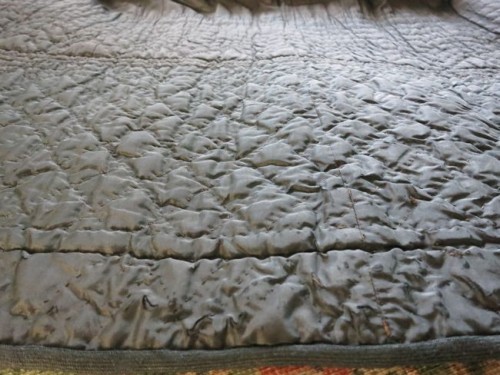
Yes, I am now the proud, thrilled, and somewhat overwhelmed owner of a quilted petticoat.
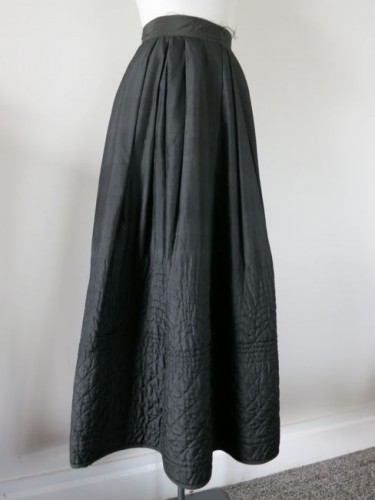
How? Where?
More like who. The amazing Lynne bought it in an antique store in London some years ago, and I got to visit her in March, where she played doting honourary aunt/textile fairy godmother and gave it to me.
I know, how amazing, phenomenal and wonderful is that?
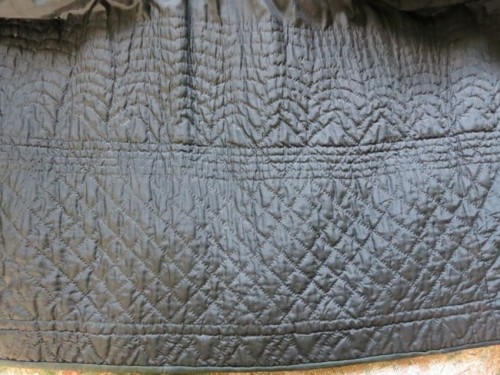
The petticoat is made of black silk taffeta, and is lined in a very soft, rather loosely woven, cream cotton, now rather soiled.
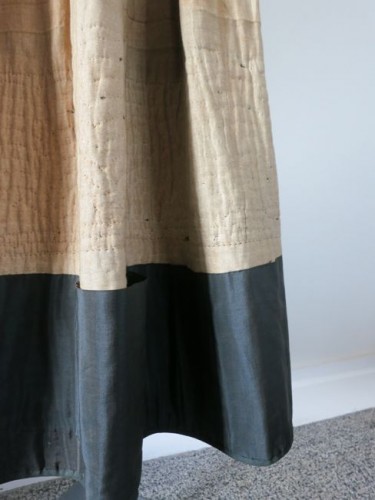
The quilting only extends about 2/3 of the way up the petticoat, and the ‘length has been regulated’, to use a delicious old sewing phrase, from the top of the petticoat, with the additional fabric folded up in to the interior of the skirt.
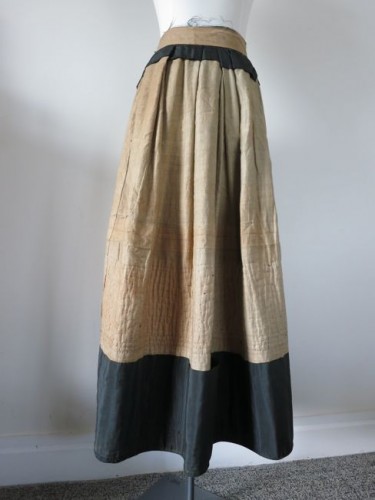
The hem is faced in a fascinating fabric – I think its a silk/wool blend, and the very bottom bound in a course wool.

The petticoat is entirely hand sewn with what appears to be silk thread, with approximately 12 stitches per inch (6 if you only count the ones showing on the top of the fabric). The stitching, while fine, is not exquisite, indicating a seamstress who was either less skilled, or simply wanted a functional garment, quickly.
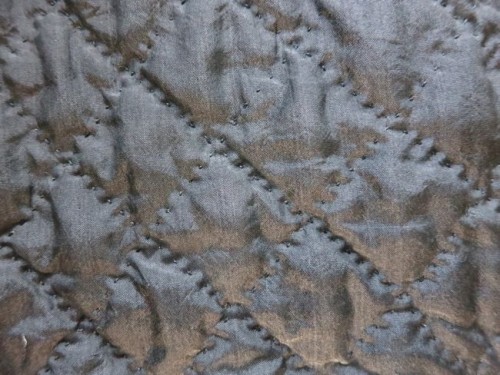
Large basting stitches are used on other portions of the petticoat, where smaller stitches weren’t needed for strength or visual effect.
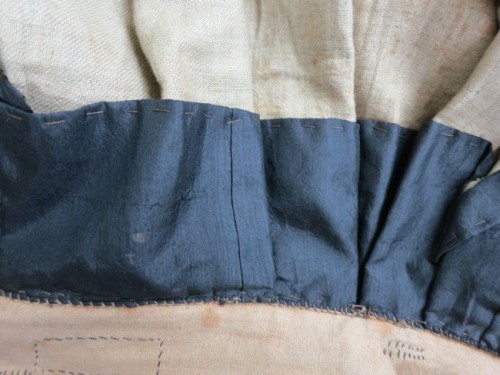
The petticoat has a later mend: a large patch to one side. The patch has been carefully placed to match the lines of quilting, making it as inconspicuous as possible. I wonder what happened to the quilt to require such a large patch. A scorch perhaps?

The stitching on the patch is considerably larger and less even than the original stitching on the petticoat, indicating it was done by a different seamstress.
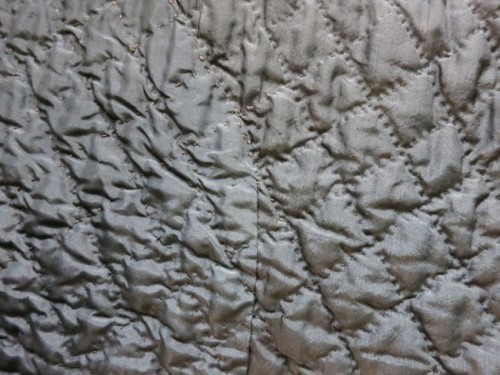
The patch, like the rest of the petticoat, is also a black silk taffeta, but it definitely dates from a few decades later than the rest of the petticoat. It’s crisper, shinier, and is quite friable, indicating it was probably ‘weighted’ – a practice of adding metal to silk sold by weight, to make it heavier. Unfortunately weighting silk accelerates its disintegration.

The hem binding goes over the patch, so either it was carefully unpicked and replace, or, like the patch, it is a later addition to the skirt.
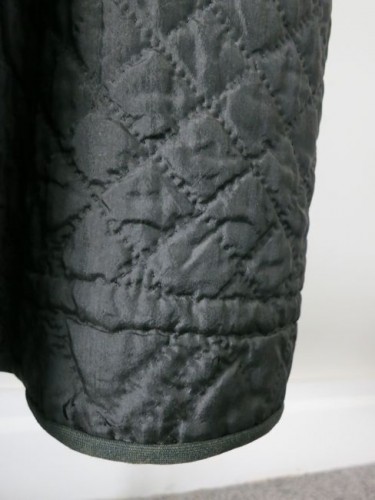
The waistband of the skirt is also probably a later replacement. It is heavily damaged: mended, patched, and disintegrating in parts:
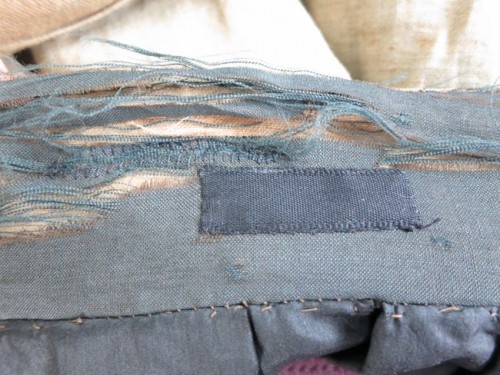
It’s particularly damaged where the buttons are sewn on to the waistband, where the fabric would have pulled and strained the most. There are two different buttons, allowing it to be fastened at different waist sizes. The one on the left is wood, and I haven’t managed to identify the materials of the one on the right. The larger waist size is around 29″, and the smaller 27/5″.
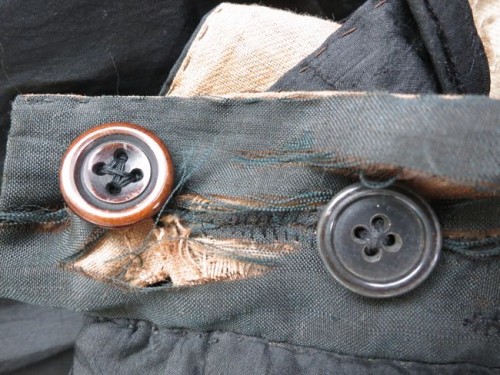
The buttonholes are worked by hand with lovely even buttonhole stitches, in linen thread.
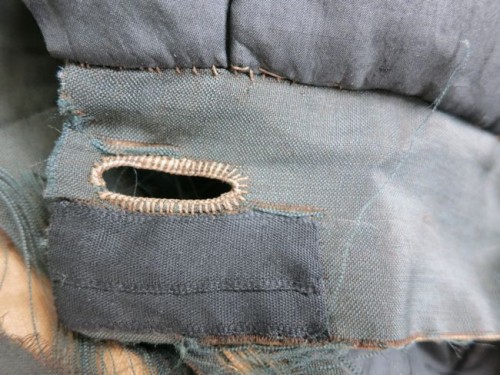
I’m quite madly in love with how beautiful the buttonhole is in fact. One day I shall make hand-sewn buttonholes as beautiful as this…
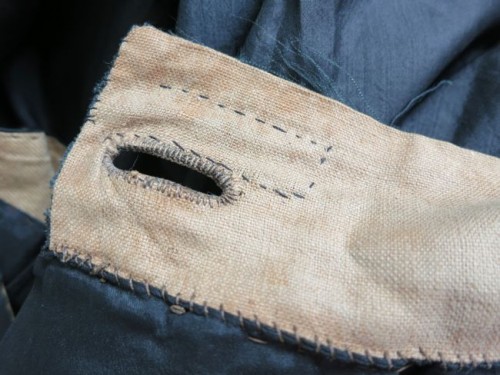
The rather wide waistband is backed in an unbleached cotton, and is joined to the skirt with strong, secure whipstitches in linen thread:

The waistcoat is gathered in with pleats rather than gathering, though the lack of quilting means the fabric is thin enough to have gathered successfully.
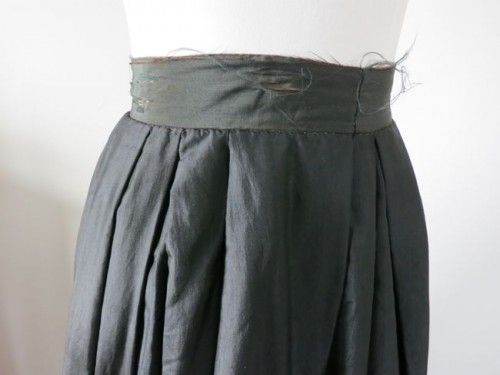
The pleating isn’t even around the skirt, particularly at the placket, where extra pleats have been added to hide the placket. This makes the skirt hang rather oddly.

The weight at the hem of the skirt, and the thinness of the upper fabric makes the skirt hang rather straight and limp, and I wonder if something (paniers? A corded petticoat?) was meant to have been worn under the quilted petticoat to give it shape.
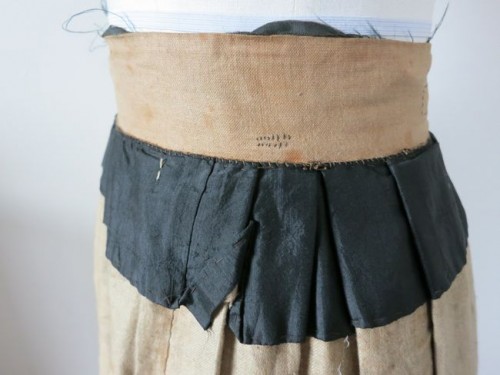
Dating the petticoat is a bit of a conundrum. The simpler, more geometric based quilting pattern is far more common in later, 1840s quilted petticoats, and the mends are later yet: probably 1860s or later. The materials are also consistent with an 1840s dating, though they aren’t impossible for the 18th century. The attachment to the skirt, with pleats concentrated on either side, means that it could go over paniers – but the waistband (or at least the outer waistband fabric) is probably a later addition, so that makes no sense.
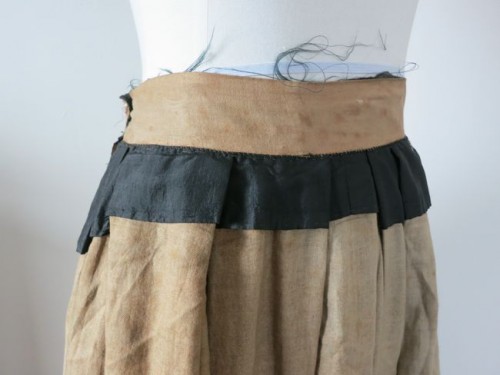
I think I’ll go with 1840s as a tentative dating, and keep studying and researching – and trying to see more quilted petticoats in person, to better date mine.
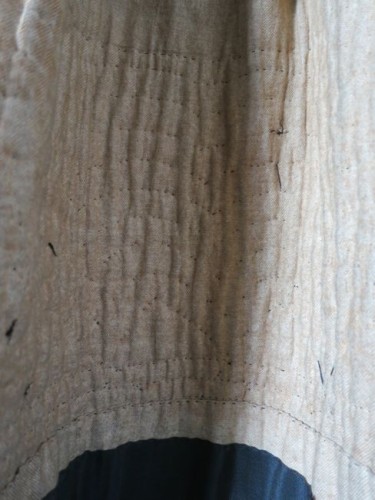
Dearest Lynne, thank you for an utterly gorgeous piece of fashion history, and hours and hours or research fun!
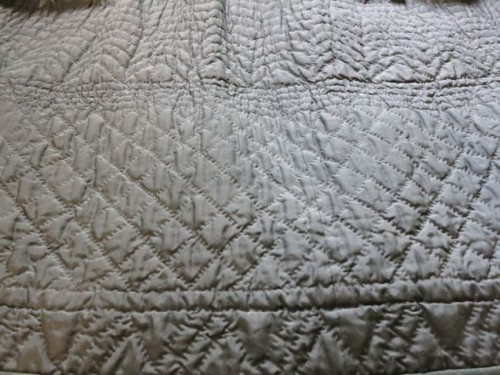

I just knew I had found it a good new home!
What interesting thoughts about the waistband/pleating. Are there any signs that it could have been gathered to an earlier band? I never looked. I’d been thinking the sleeker waist/hip line was to allow for the overgown to have seriously pouffly side pieces.
It has found an adoring, very grateful home!
I do think the waistband has been replaced/altered, but I can’t find any clear indication of a different pleating/gathering pattern.
Oh my, that is very, very special.
Isn’t it fantastic? I just sit and look at it and make happy sighs.
What a gift! Thank you so much for all the comments and details.
You’re welcome! I felt I should pass on the gift as much as I was able.
It’s beautiful! How sweet of your friend to give it to you for your collection.
Isn’t it gorgeous? And Lynne is gorgeous too!
I really enjoyed reading your analysis of this petticoat. So interesting! And you are so right about the buttonhole; it almost makes me want to practice.
What a wonderful item for your collection. Lynne must be a very good friend indeed!
I am so beyond thrilled to have it as part of my collection, and Lynne is truly amazing and wonderful, and ridiculously generous!
So cool! Did people really use clothes for 100 years? I mean, besides the ceremonial things? Was it really possible to have a working item for a century? (If it does date to the 18th century)
Well, I’m still wearing the coat my mother made for herself in the early 1960s. I see no reason why it shouldn’t last another fifty years. Black fake astrakhan with a black and yellow lining. Car coat – classic style. It has been in regular use as a “good” coat all this time. Can anyone beat that?
Wow–sounds gorgeous! Amazing how classic things last and last.
People certainly did use things for 100 years – there are dresses made from 1730s fabric that were restyled in the 1760s, and then again in the 1780s, and then again in the 1840s! The fabric of this is not quite as robust though.
How interesting! The pattern didn’t ‘date’ the fabric? Beautiful and interesting gift. So neat.
Congratulations! What a special thing to have. Thanks for sharing the pictures. That button hole is divine to look at 🙂
Caroline
You’re welcome! I really do feel that I need to pass on the love as much as possible! And I’m glad I’m not the only one who is made happy by buttonholes!
How awesome! You do have the best friends! I hope you’re able to find even more out about it later on.
Yep! Me too! I dream of a study trip to the US or the UK – looking at other examples like this in museums…